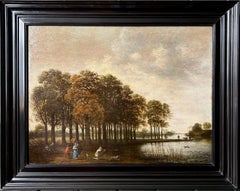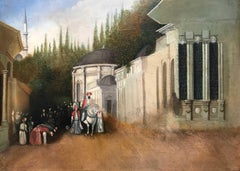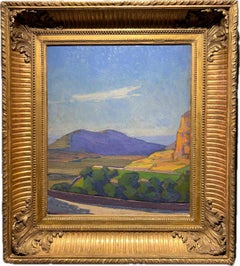Want more images or videos?
Request additional images or videos from the seller
1 of 5
Attributed to Dominic SerresHMS Chatham off the coast of America1780
1780
$24,513.73List Price
About the Item
- Creator:Attributed to Dominic Serres
- Creation Year:1780
- Dimensions:Height: 28 in (71.12 cm)Width: 40 in (101.6 cm)
- Medium:
- Movement & Style:
- Period:1780-1789
- Condition:
- Gallery Location:London, GB
- Reference Number:1stDibs: LU5245967452
About the Seller
5.0
Vetted Professional Seller
Every seller passes strict standards for authenticity and reliability
Established in 2007
1stDibs seller since 2014
85 sales on 1stDibs
Typical response time: 2 hours
Authenticity Guarantee
In the unlikely event there’s an issue with an item’s authenticity, contact us within 1 year for a full refund. DetailsMoney-Back Guarantee
If your item is not as described, is damaged in transit, or does not arrive, contact us within 7 days for a full refund. Details24-Hour Cancellation
You have a 24-hour grace period in which to reconsider your purchase, with no questions asked.Vetted Professional Sellers
Our world-class sellers must adhere to strict standards for service and quality, maintaining the integrity of our listings.Price-Match Guarantee
If you find that a seller listed the same item for a lower price elsewhere, we’ll match it.Trusted Global Delivery
Our best-in-class carrier network provides specialized shipping options worldwide, including custom delivery.You May Also Like
Large 17th century Italian old master - Noli me tangere, Christ in the garden
By Pier Francesco Cittadini
Located in Aartselaar, BE
Large 17th Century Italian Old Master, The Garden - Noli me tangere, Pier Francesco Cittadini (attr.)
Description
In the stillness of a garden in bloom, Noli me tangere captures a p...
Category
17th Century Old Masters Figurative Paintings
Materials
Canvas, Oil
$10,551
H 31.89 in W 40.56 in
Italian Mountainous River Landscape - French 19th Century Neo Classical art
Located in Hagley, England
This stunning Neo Classical French 19th century landscape oil painting is by acclaimed French artist Jean Victor Bertin. He was also an early proponent of sketching out doors and dir...
Category
19th Century Old Masters Landscape Paintings
Materials
Oil
Jean Victor Bertin Italian Mountainous River Landscape - French 19th Century Neo Classical art, 1827
$81,712 Sale Price
20% Off
H 29 in W 37 in D 2 in
Rotterdam Port See Italian Paint Oil on canvas 18th Century Old master Flemish
Located in Riva del Garda, IT
Pair of views of Rotterdam: The Stock Exchange building / View of the canal with the old port
Eighteenth-century Vedutist painter
oils on canvas
47 x 66 cm. - with frame 56 x 75 cm.
This pleasant pair of paintings depict two glimpses of the city of Rotterdam, investigated here as vivid documentaries of the habits and customs from the public life of the wealthy Dutch port city, as well as one of the founders of the Dutch East India Company, is an excellent example of 18th century Vedutism
We see, in particular, in the first work the monumental Palazzo della Borsa (defined as Il Beurs), designed by the architect Adriaen van der Werff in Westnieuwland, initially a place destined for legislation on trade, where merchant-bankers met periodically to exchange securities credit and enter into sales; it is located on the bank of the Nordblaak River and shot with the Gaapers Bridge in the foreground.
The second work immortalizes the docking of the ancient port of Rotterdam, with the foreground view of the two city gates (the Wester Old Hoofdpoort on the left and the Ooster Oude Hoofdpoort on the right); in the background on the left the St. Laurenskerk (Church of San Lorenzo), also called the Great Church of Rotterdam, is the only medieval structure, while on the right the English Church.
Very well executed, characterized by a marked brightness and a chromatic range with bright colors and highlighted by the contrast between lights and shadows, our canvases are a very interesting testimony of eighteenth-century Rotterdam, portraying two of the views that have historically influenced a lot on economic history of the city.
We can attribute the authorship to an author of the full eighteenth century, inspired by the pictorial style of the Italian landscape painters and whose iconography was presumably drawn from the numerous prints with perspective views made through the optical cameras.
In particular, these views of Rotterdam draw their iconographic origin from a collection of perspective prints of the most influential European cities, made by the engraver Johann Balthasar Probst (1732-1801), characterized by a remarkable refinement in the line, at the service of a sense of perspective of undoubted value, and above all characterized by a strong Nordic taste.
Descendant of a large family of Augsburg engravers, Probst contributed to making his workshop an important European publishing center between the 17th and 18th centuries, among the major German print publishers in the first half of the 18th century.
Despite his travels, including in Italy, between Venice, Rome and Naples, not all the cities he portrayed were drawn from life but taken from earlier prints and drawings and filtered through northern European clichés.
Many of these engravings have been lost and are now difficult to find on the antiques market.
Category
18th Century Old Masters Paintings
Materials
Oil
$10,808 Sale Price
20% Off
H 22.05 in W 29.53 in
Landscape See Paint Oil on canvas Flemish Old master 18th Century Italian Art
Located in Riva del Garda, IT
Flemish painter active in Italy in the eighteenth century
Coastal landscape of the Mediterranean with architectures and figures
Oil painting on canvas (69 x 88 cm., in frame 80 x 100 cm.)
The suggestive view proposed depicts a coastal view with a bay and the ruins of an ancient building, probably a monastery or a church, and in the background another building with a garden surrounded by high walls close to the shore.
The type of landscape, typical of the southern Italian environment, and the intimate atmosphere that welcomes the scene, attributes the authorship of the work to a landscape painter active in the eighteenth century, presumably in Italy in this period, with immediate references to the Dutch school , and in particular to the production of Jacob de Heusch and above all of Gaspar van Wittel, considered the progenitor of Italian landscape painting.
In fact, in the rendering of the architectural details, in the purity with which the buildings have been reconstructed, as well as in the atmosphere that encompasses the entire landscape, a marked correspondence to the so-called "Vanvitellian realism" can be seen: in fact, a comparison with a certain series of views which the Dutchman...
Category
18th Century Old Masters Paintings
Materials
Oil
$7,027 Sale Price
20% Off
H 31.5 in W 39.38 in
Tivoli Waterfall through Ponte Lupo - British Old Master landscape oil painting
Located in Hagley, England
This superb exhibited British 18th century Old Master Italian landscape oil painting is by noted artist Thomas Barker of Bath. Painted in 1794 and exhibited at the Royal Academy in 1...
Category
18th Century Old Masters Landscape Paintings
Materials
Oil
$32,684 Sale Price
20% Off
H 46 in W 38 in D 2 in
Arcadian Italian Landscape - Old Master 17thC French oil painting herdsman sheep
By (Attributed to) Gaspard Dughet
Located in Hagley, England
A delicate oil on canvas landscape capriccio of an Arcadian landscape with figures and sheep and goats in the foreground. A stormy sky and blasted tree populate the landscape and the...
Category
17th Century Old Masters Landscape Paintings
Materials
Oil
$13,073 Sale Price
20% Off
H 26 in W 32 in D 2 in
Shepherd with Animals in Landscape - Dutch Old Master art pastoral oil painting
By Nicolaes Berchem
Located in Hagley, England
This lovely Dutch Old Master oil painting is attributed to noted Dutch artist Nicholaes Berchem. Painted circa 1665 it is a charming pastoral scene of a shepherd and his animals including sheep, goats, donkey and cows and of course his trusty dog. They are all resting beneath trees while he looks on attentively. The light in the sky and the light and shadows on the animals is beautiful. A really superb example of Dutch Old Master art with great detail.
Provenance. Surrey estate.
Christies stamp verso.
Condition. Oil on canvas, 38 inches by 32 inches and in good condition.
Frame. Housed in a complementary gilt frame, 46 inches by 30 inches and in good condition.
Nicolaes Pieterszoon Berchem (1620-1683) was a highly esteemed and prolific Dutch Golden Age painter of pastoral landscapes, populated with mythological or biblical figures, but also of a number of allegories and genre pieces. He was a member of the second generation of "Dutch Italianate landscape" painters. These were artists who travelled to Italy, or aspired to, in order to soak up the romanticism of the country, bringing home sketchbooks full of drawings of classical ruins and pastoral imagery. His paintings, of which he produced an immense number, (Hofstede de Groot claimed around 850, although many are misattributed), were in great demand, as were his 80 etchings and 500 drawings. His landscapes, painted in the Italian style of idealized rural scenes, with hills, mountains, cliffs and trees in a golden dawn are sought after. Berchem also painted inspired and attractive human and animal figures (staffage) in works of other artists, like Allaert van Everdingen, Jan Hackaert, Gerrit Dou, Meindert Hobbema and Willem Schellinks. Born in Haarlem, he received instruction from his father Pieter Claesz, and from the painters Jan van Goyen, Pieter de Grebber, Jan Baptist Weenix, Jan Wils and Claes Cornelisz. Moeyaert. According to Houbraken, Carel de Moor told him that Berchem got his name from two words "Berg hem" for "Save him!", an expression used by his fellows in Van Goyen's workshop whenever his father chased him there with the intent to beat him. No trip or Grand Tour by Berchem was documented by Houbraken though he mentioned another story about the "Berg hem!" nickname which came from Berchem's conscription as a sailor; the man in charge of impressment knew him and sent him ashore with the words "Save him!". Today his name is assumed to come from his father's hometown of Berchem, Antwerp. According to the RKD he traveled to Italy with Jan Baptist Weenix, whom he called his cousin, in 1642–5. Works by him are signed both as "CBerghem" and "Berchem". In 1645 he became a member of the Dutch reformed church and married the year after. According to Houbraken he married the daughter of the painter Jan Wils, who kept him on a short allowance, but to finance his collection of prints he would borrow money from his pupils and colleagues and pay them back from the proceeds of paintings that he didn't tell her about. Around 1650 he travelled to Westphalia with Jacob van Ruisdael, where a dated piece showing Burg Bentheim is recorded. Maybe Berchem went to Italy after this trip and before he moved to Amsterdam - he is not clearly documented in the Netherlands between 1650 and 1656. Around 1660 he worked for the engraver Jan de Visscher designing an atlas. In 1661-1670 he is registered in Amsterdam and in 1670 he moved back to Haarlem, but was living back in Amsterdam by 1677, where he died in 1683. He was a popular teacher and his pupils were Abraham Begeyn, Johannes van der Bent, his son Nicolaes, Isaack Croonenbergh, Simon Dubois, Karel Dujardin, Johannes Glauber, Pieter de Hooch, Jacob van Huchtenburg, Justus van Huysum...
Category
17th Century Old Masters Landscape Paintings
Materials
Oil
$15,245 Sale Price
20% Off
H 30 in W 46 in D 2 in
Old Master Dutch Female Nude Arcadian Landscape - 19th century art oil painting
By (Attributed to) Isaac de Mucheron
Located in Hagley, England
An original oil on canvas which is attributed verso to Isaac Mucheron with figure by Vandveldt. The scene depicts a nude in an Arcadia classical landscape with ruins. Fresh colour an...
Category
Early 19th Century Old Masters Landscape Paintings
Materials
Oil
$8,062 Sale Price
20% Off
H 32 in W 28 in D 2 in
Italian Landscape with Travellers - Dutch Golden Age 17thC art oil painting
Located in Hagley, England
This superb Dutch Golden Age Old Master landscape oil painting is attributed to Jacob van der Croos. Painted circa 1670 it is an Italianate landscape with figures and their animals i...
Category
17th Century Old Masters Landscape Paintings
Materials
Oil
$17,431
H 38 in W 32 in D 2 in
Cattle and Drover in a Landscape - British Victorian art landscape oil painting
Located in Hagley, England
This gorgeous oil on canvas Victorian Old Master painting is by British artist Henry Jutsum. Painted circa 1850 the painting depicts a drover on horse back bringing up the rear behin...
Category
19th Century Old Masters Landscape Paintings
Materials
Oil
$5,992 Sale Price
20% Off
H 40 in W 35 in D 2 in
More From This Seller
View AllHeron Shoot in a Landscape
Located in London, GB
Joris Abrahamsz van der Haagen
Heron Shoot in a Landscape
1615-1669
Oil on oak panel, signed 'JAH' lower left
Image size: 16 x 21 inches (41 x 53 cm)
Dutch ebonised frame
Provenance...
Category
17th Century Old Masters Landscape Paintings
Materials
Oil, Panel, Oak
Le Pont de Sully, Paris, French School, Oil Painting
Located in London, GB
French School
19th Century
A Harbour
Oil on board
Unsigned
Image size: 8 x 10 inches
Contemporary frame
The current bridge was constructed back in 1876 and named the Pont Sully, or...
Category
19th Century Landscape Paintings
Materials
Canvas, Oil
Turkish Scene, 19th Century British School Victorian
Located in London, GB
British School
19th Century
Leaving the Palace, Turkey
Oil on panel, unsigned
Image size: 13 ½ x 10 ½ inches
Giltwood framed
This is a rare painting of early life in Turkey, the wor...
Category
19th Century Victorian Landscape Paintings
Materials
Board, Oil
Route de Montagne
Located in London, GB
Robert Deborne
French 1870 -
Oil on canvas, signed bottom right
Image size: 20 1/2 x 24 1/2 inches (53 x 62 cm)
Original gilt frame
Provenance
Artist’s Estate
Robert Deborne
Ro...
Category
20th Century Impressionist Landscape Paintings
Materials
Canvas, Oil
Kimmeridge Bay, 20th Century English School Oil Landscape, Monogrammed
Located in London, GB
Oil on canvas, monogrammed bottom right, inscription and artist label on stretcher
Image size: 12 x 24 inches (30.5 x 61 cm)
Original frame
Provenance
Collection of Mrs Fairchild, L...
Category
20th Century Modern Landscape Paintings
Materials
Canvas, Oil
David with the Head of Goliath, 19th Century Victorian Oil
By John Rogers Herbert
Located in London, GB
John Rogers Herbert RA
1810- 1890
Oil on canvas, dated '1850' lower right on sword strap
Image size: 33 ½ x 23 ½ inches
Gilt Watts frame
This striking painting, depicts David as a y...
Category
1850s Victorian Figurative Paintings
Materials
Oil
Recently Viewed
View AllMore Ways To Browse
Prints By Sir William Hamilton
Antique Broadside
Chatham Painting
Dominic Serres
William Parry
Battle Of Bunker Hill
Connecticut Impressionist Paintings
Dan Welden
David Hamilton
Elizabeth Chalmers
English Landscape With Church
Eugene Maziarz
Florence Arno
Florence Ponte Vecchio
George Vicat Cole
Godard Gabriel
Haitian Landscape
Hawaiian Seascape


